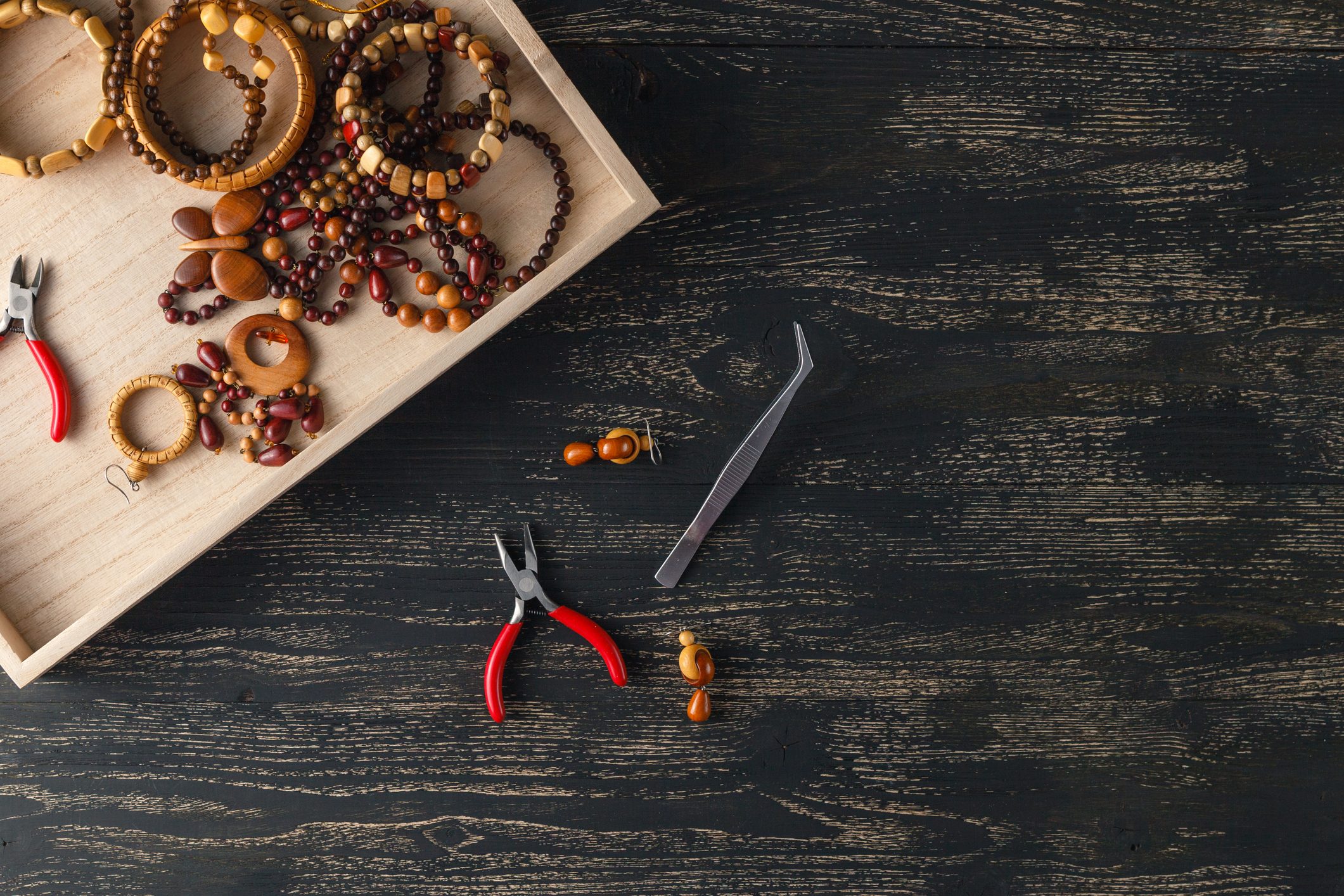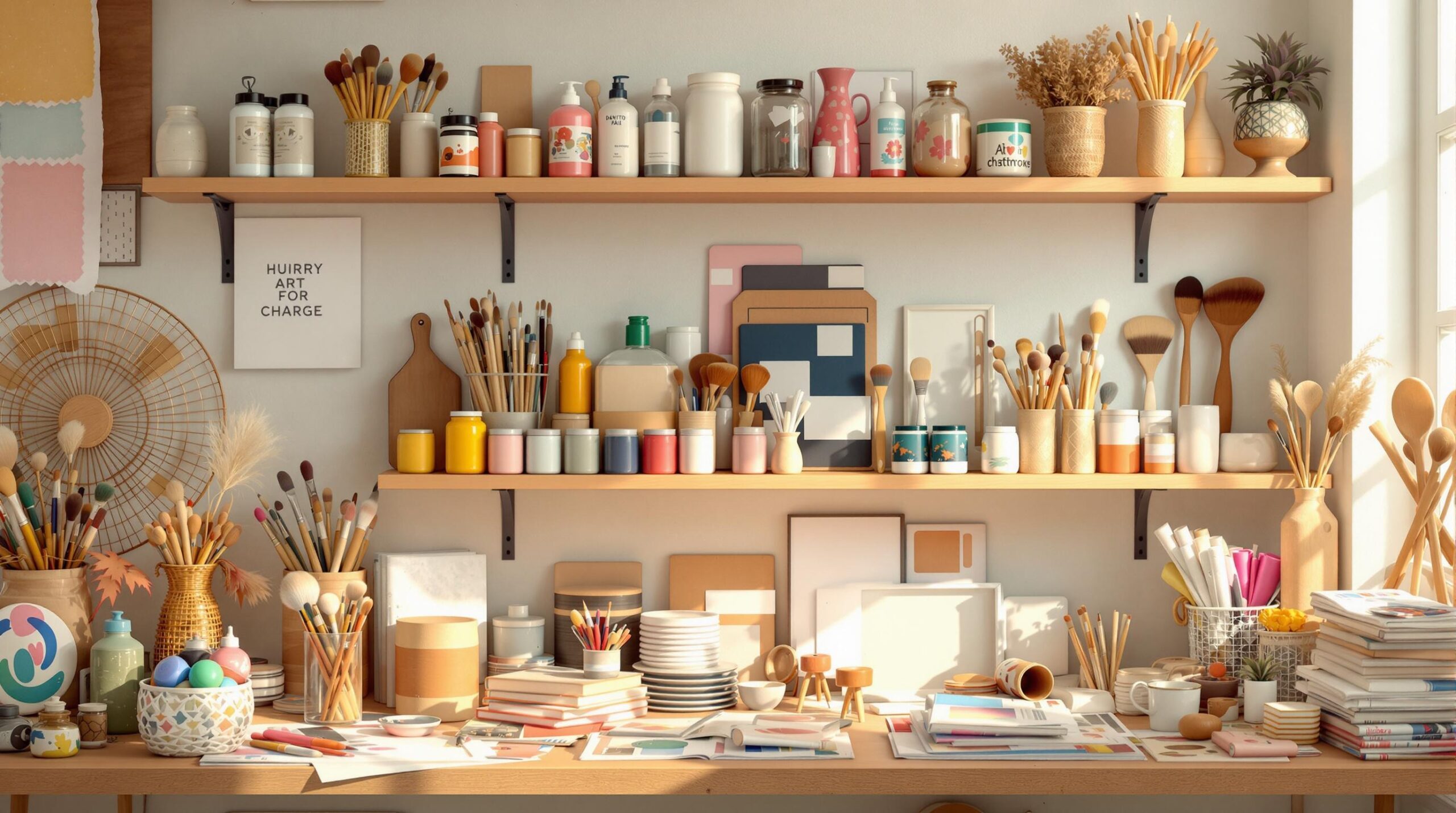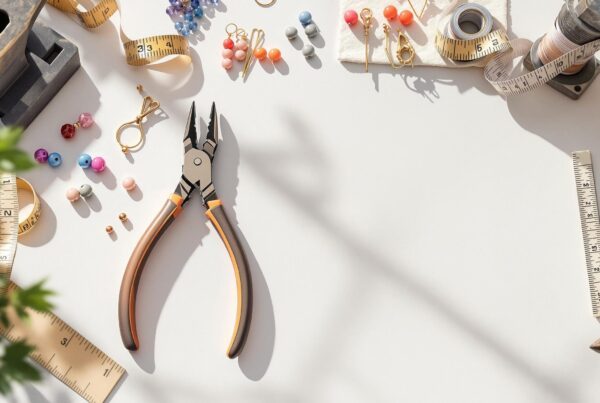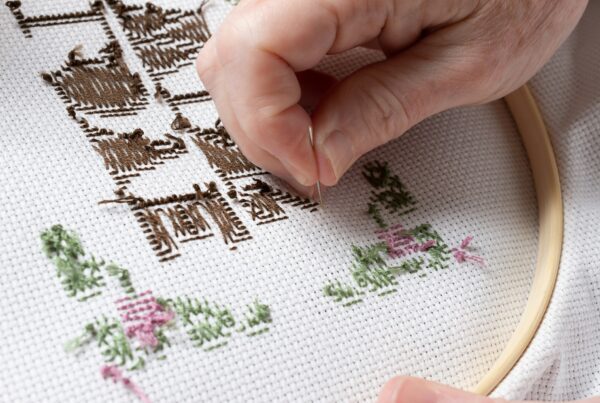An Introduction to Jewellery Making
In this article, we’ll break down the art of jewellery making and why it’s so important for your creative expression:

What is Jewellery Making and Its Benefits
Jewellery-making is crafting pieces of jewellery by hand by using various techniques. Although many people use machines to create jewellery—handmade jewellery is still extremely popular in the market.
The benefits of making hand-made jewellery are plentiful:
- Creative expression: Jewellery making allows you to showcase your creativity and personal style.
- Relaxation: Many find the process of making jewellery calming and therapeutic because of its creativity.
- Unique creations: Handmade jewellery is unique and personalised, making it special for the maker and the wearer.
- Skill development: As you advance in jewellery making, you develop a range of skills—including basic beading to advanced metalwork.
Other benefits of jewellery making are the ability to constantly learn and innovate, the joy of experimenting with new materials and designs, and the opportunity to participate in craft fairs and exhibitions.
”Jewellery making is an outstanding way to relax & be creative!
ThemeNectar
The Ancient Beginnings
Jewellery-making dates back thousands of years, with early humans using natural materials—such as bones, shells, and stones to make simple adornments.
In addition, these primitive pieces often held symbolic meanings or were used in rituals and ceremonies. As human societies evolved, the art of jewellery-making also developed.
Classical Civilizations
Jewelry-making became especially popular among the classic civilizations. The Egyptians, Greeks, and Romans significantly advanced jewelry-making techniques worldwide.
People admired the Egyptians for their intricate gold jewellery with colourful gemstones and glass. Furthermore, jewellery in ancient Egypt often symbolized power, wealth, and religious beliefs.
Greek and Roman jewellery—characterized by its elegance and sophistication—also used gold and gemstones.
The Middle Ages
During the Middle Ages, jewellery became more ornate and symbolic. They used precious stones and metals, and pieces often featured religious motifs and heraldic symbols.
Similarly, one technique enameling became a popular technique because it added vibrant colours to metal was a sign of status and wealth worn by the nobility and royalty.
The Renaissance
The Renaissance era brought a resurgence in the appreciation of art and craftsmanship; this included jewellery making. For instance, artisans experimented with new techniques and materials to create highly detailed and ornate pieces.
The Industrial Revolution
The Industrial Revolution—largely started in the United Kingdom—marked a significant turning point in jewellery making. The creation of machinery mass-produced jewellery, which made it more accessible to the general public.
Nonetheless, this period also sparked a renewed interest in handcrafted jewellery because people wanted unique and personalised pieces.
The Modern Era
Jewellery-making continues to evolve—blending traditional techniques with contemporary designs—in the modern era. Advances in technology, such as 3D printing and laser cutting, have opened new possibilities for jewellery artisans.
Choosing Your Path
There are several paths you can take in jewellery making; each option comes with its techniques and materials.
Here are some of the best examples:
Types of Jewellery Making: Beaded, Wire, Silver, and Goldsmithing
- Beaded: This involves attaching beads by stringing them with a needle and thread or thin wire. It’s perfect for beginners and allows for a lot of creativity.
- Wire loops: This type uses wire wrapping techniques to shape and form wire into beautiful pieces. It needs basic tools like pliers and wire cutters.
- Silver and Goldsmithing: This advanced skill involves shaping precious metals into jewellery and small objects. It includes techniques like soldering, casting, and metal clay work.
Exploring Jewellery-Making Kits for Beginners
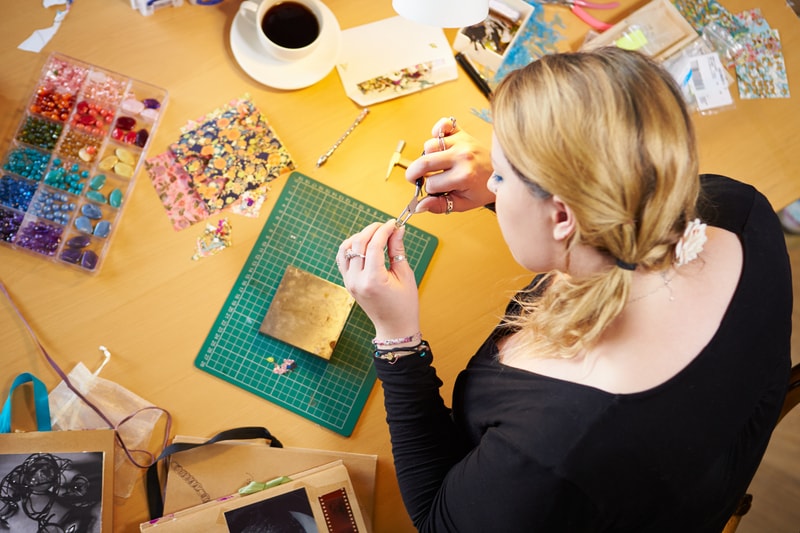
Crafting kits are a wonderful way to start because they provide all the necessary materials and tools. They’re perfect for beginners because they offer a step-by-step guide to creating beautiful earrings.
Here are some of the other advantages of using crafting kits:
- Convenience: All necessary materials and tools are included. This reduces the need to shop for individual items.
- Cost-effective: Kits often cost less than buying each component separately. As a result, this saves you tons of money.
- Variety: Kits provide a diverse range of materials. This helps you explore different styles and techniques.
- Learning opportunity: Jewellery-making kits are ideal for beginners; they often come with instructions or guides, making it easy to learn the basics.
- Creative outlet: a fun and creative activity. Therefore, this allows you to design and create unique pieces.
Essential Tools and Materials for Jewellery Making
It’s possible to make jewellery with the bare minimum tools and materials if you’re smart.
However, some tools go a long way to providing excellent creative jewellery without spending much money. Let’s jump into these:
Jewellery-Making Supplies: Beads, Wires, and More
- Beads: Glass beads, seed beads, gemstone beads, and more: each type offers different aesthetics and uses.
- Wires: Beading wire, copper wire, silver-plated wire, and more. The choice of wire affects the durability and look of your pieces.
- Findings: Jump rings, earring backs, clasps, and more—which are essential components for assembling your trinkets.
Jewellery Making Supplies: Pliers, Cutters, and Other Essentials
- Basic Tools: Round nose pliers, flat nose pliers, chain nose pliers, wire cutters, and more. These tools help in shaping and manipulating your materials.
- Professional Tools: Sterling silver and gold-filled are ideal for a polished finish, and you can purchase these without too much expense,
Mastering Basic Jewelry Making Techniques
1. Working with Jump Rings and Other Jewelry Findings
You should learn to properly open and close jump rings to connect components securely. For example, mastering this skill ensures your pieces are functional and durable.
Additionally, correctly attaching findings like clasps and earring backs is crucial for the integrity and usability of your jewellery.
2. Wire Wrapping and Shaping Basics
Wire wrapping involves creating loops, twists, and coils to secure beads and components. You can craft intricate designs and enhance your creations.
Furthermore, you should shape wire into various forms to add unique elements to your creations.
3. Beading and Stringing Techniques
You should explore stringing, knotting, and weaving techniques to create beautiful beaded jewellery. Stringing beads on wire or thread is essential for making necklaces and bracelets.
Likewise, knotting prevents beads from sliding and adds a decorative touch, while weaving techniques like macramé offer intricate patterns and textures.
Designing Your Handmade Jewelry
1. Finding Inspiration for Your Jewelry Designs
It’s important to get inspired by nature, art, fashion, and more. Creating a mood board or Pinterest board can help visualise your designs and keep your ideas organised without spending any money.
2. Designing Your Piece: Tips and Considerations
You should consider the occasion, personal style, and skin tone when designing your piece. Think about the materials, colours, and textures you want to use. This thoughtful approach ensures your jewellery is both beautiful and meaningful.
Taking Your hobby to the Next Level
1. Advanced Techniques: Soldering, Casting, and More
As you become more skilled, you can explore advanced techniques: soldering, casting, and working with metal clay. These techniques open up new possibilities for creating intricate and professional-quality jewellery.
2. Pricing and Selling Your Handmade Jewelry
You should also learn how to price your jewellery. To do this, take into account your materials, time, and expertise.
You should also consider selling online, at craft fairs, or in local jewellery stores. Finally, understanding the market and your unique selling points can help you turn your hobby into a profitable venture.
Learning Resources and Community

1. Find Inspiration in online Classes and Workshops
You should take classes or workshops from experienced jewellery makers to accelerate your learning and provide hands-on experience. It’s also a fantastic way to meet fellow enthusiasts and build a supportive network.
2. Online Tutorials and Guides
Follow online courses and guides, including YouTube videos and blog posts. You can join online communities and forums that can connect you with other jewellery makers; this allows you to share your work, get feedback, and learn from others.
Troubleshooting Common Problems
Common Mistakes to Avoid Making Jewelry
You should avoid common mistakes like using low-quality materials or not following safety precautions.
Likewise, proper technique and attention to detail are crucial for creating durable and beautiful jewellery.
Fixing Errors and Improving Your Skills
It’s important to learn how to fix common errors like broken jump rings or tangled wires.
Remember, continuous practice and improvement are key to becoming a confident jewellery maker.
Final Thoughts
Jewellery-making is a rewarding and creative hobby that offers endless possibilities. If you learn to understand the basics and choose the right materials and tools—you can create stunning handmade jewellery.
Take the next step in your journey, and let your creativity shine!
FAQs
How do I Start Making My Jewellery?
It’s simple to start your jewellery-making process. You can start with a basic kit and materials, and consider using a beginner’s kit. You can also follow online courses or take a class to learn basic techniques.
Is it Profitable to Make Jewellery?
Yes, with the right skills, materials, and marketing itcan be a profitable business or income.
What’s the easiest to Make?
Beaded earrings are often the easiest when starting out because it requires minimal tools and skill levels.
Can You Make Money Selling Homemade Jewelry?
Yes, many people successfully sell handmade jewellery online, at craft fairs, and in local stores.
I’m a complete beginner, what are the first steps?
The basic steps include designing, choosing materials, assembling, and finishing your piece. You shouldn’t overcomplicate things: it can be straightforward.
How profitable is Jewellery Making?
Profitability depends on factors. These include material costs, time invested and how much you spend on jewellery making supplies.
What basic skills do you need
You can use essential tools, like beads and wire loops, sterling silver, and precious metals to complete your pieces. As a result, you can make excellent trinkets without spending much cash.
How do I start learning jewellery-making?
There are ample ways to learn how to make jewellery. You can begin with online courses, books, or local classes to learn basic techniques.
What do you need to start making jewellery?
You don’t need many tools. You can simply use tools (pliers, cutters), materials (beads, wire), and findings.
What is the easiest type of jewellery to make?
Beaded earrings are often the easiest and most accessible for all skill levels. It doesn’t take much time, effort, or skill to make.
Is making jewellery easy?
It can be simple, especially with the right guidance and practice. Start with simple projects and gradually take on more complex ones.
What do I need to start making my jewellery?
You only need basic tools, materials, and a willingness to learn and experiment.
What qualifications do you need to make jewellery?
No formal qualifications are necessary for hobbyist jewellery making, but advanced techniques may require specialised training.
How do I get into jewellery making?
Start with basic projects, take classes, and gradually expand your skills and materials.
Is jewellery-making profitable?
It can be, especially if you develop unique designs and get your designs into jewelry stores
Is making jewelry expensive?
It can be relatively inexpensive to start with basic materials and tools, but costs can increase with more advanced projects.
How to make handmade jewelry at home?
Set up a workspace with essential tools and materials, follow tutorials, and practise your techniques.
Can you make jewellery from home?
Absolutely! Many successful jewellery makers create their pieces from home; they use a dedicated workspace to house their jewellery making supplies.


